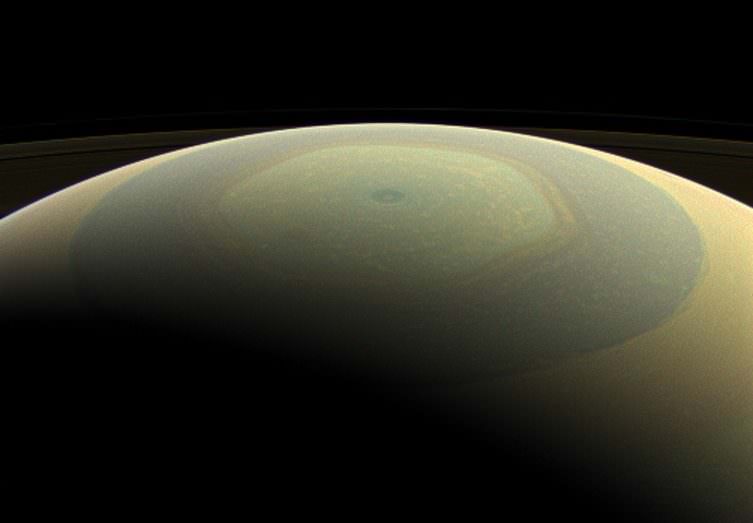Ever since the
*Voyager 2*
made its historic flyby of Saturn, astronomers have been aware of the persistent hexagonal storm around the gas giant's north pole. This a six-sided jetstream has been a constant source of fascination, due to its sheer size and immense power. Measuring some 13,800 km (8,600 mi) across, this weather system is greater in size than planet Earth.
And thanks to the latest data to be provided by the
Cassini space probe
, which entered orbit around Saturn in 2009, it seems that this storm is even stranger than previously thought. Based on images snapped between 2012 and 2016, the storm appears to have undergone a change in color, from a bluish haze to a golden-brown hue.
The reasons for this change remain something of a mystery, but scientists theorize that it may be the result of seasonal changes due to the approaching summer solstice (which will take place in May of 2017). Specifically, they believe that the change is being driven by an increase in the production of photochemical hazes in the atmosphere, which is due to increased exposure to sunlight.
[caption id="attachment_131658" align="aligncenter" width="516"]
Natural color images taken by NASA's Cassini wide-angle camera, showing the changing appearance of Saturn's north polar region between 2012 and 2016.. Credit: NASA/JPL-Caltech/Space Science Institute/Hampton University
[/caption]
This reasoning is based in part on past observations of
seasonal change on Saturn
. Like Earth, Saturn experiences seasons because its axis is tilted relative to its orbital plane (26.73°). But since its orbital period is almost 30 years, these seasons last for seven years.
Between November 1995 and August 2009, the hexagonal storm also underwent some serious changes, which coincided with Saturn going from its Autumnal to its Spring Equinox. During this period, the north polar atmosphere became clear of aerosols produced by photochemical reactions, which was also attributed to the fact that the northern polar region was receiving less in the way of sunlight.
However, since that time, the polar atmosphere has been exposed to continuous sunlight, and this has coincided with aerosols being produced inside the hexagon, making the polar atmosphere appear hazy. As Linda J. Spilker, the Cassini mission's project scientist, told Universe Today via email:
[caption id="attachment_131660" align="aligncenter" width="580"]
Diagram showing he main events of Saturn's year, and where in the Saturnian year the Voyager 1 and Cassini missions occurred. Credit: Ralph Lorenz
[/caption]
All of this has helped scientists to test theoretical models of Saturn's atmosphere. In the past, it has been speculated that this six-sided storm acts as a barrier that prevents outside haze particles from entering. The previous differences in color - the planet's atmosphere being golden while the polar storm was darker and bluish - certainly seemed to bear this out.
The fact that it is now changing color and starting to look more like the rest of the atmosphere could mean that the chemical composition of the polar region is now changing and becoming more like the rest of the planet. Other effects, which include changes in atmospheric circulation (which are in turn the result of seasonally shifting solar heating patterns) might also be influencing the winds in the polar regions.
Needless to say, the giant planets of the Solar System have always been a source of fascination for scientists and astronomers. And if these latest images are any indication, it is that we still have much to learn about the dynamics of their atmospheres.
"It is very exciting to see this transformation in Saturn's hexagon color with changing seasons," said Spilker. "With Saturn seasons over 7 years long, these new results show us that it is certainly worth the wait."
[caption id="attachment_131674" align="aligncenter" width="580"]
The seasons on Saturn, visualized with images taken by the Hubble Heritage Team. Credit: R. G. French (Wellesley College) et al./NASA/ESA/Hubble Heritage Team (STScI/AURA)
[/caption]
It also shows that Cassini, which has been in operation since 1997, is still able to provide new insights into Saturn and its system of moons. In recent weeks, this included information about
seasonal variations on Titan
, Saturn's largest moon. By April 22nd, 2017, the probe will commence its final 22 orbits of Saturn. Barring any mission extensions, it is scheduled enter into Saturn's atmosphere (thus ending its mission) on Sept. 15th, 2017.
Further Reading: NASA/JPL/Caltech
 Universe Today
Universe Today
